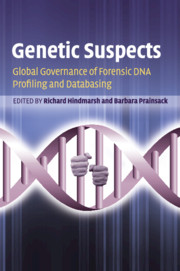Book contents
- Frontmatter
- Contents
- List of contributors
- About the contributors
- Foreword
- Acknowledgements
- 1 Introducing Genetic Suspects
- Section 1 Key areas in DNA profiling and databasing
- Section 2 National contexts of forensic DNA technologies and key issues
- 7 DNA databases and the forensic imaginary
- 8 Partners in crime: the use of forensic DNA technologies in Austria
- 9 Inquisitorial forensic DNA profiling in the Netherlands and the expansion of the forensic genetic body
- 10 DNA the Nor-way: black-boxing the evidence and monopolising the key
- 11 Portuguese forensic DNA database: political enthusiasm, public trust and probable issues in future practice
- 12 On trial! Governing forensic DNA technologies in the USA
- 13 Biosurveillance and biocivic concerns, from ‘truth’ to ‘trust’: the Australian forensic DNA terrain
- 14 Finding the balance: forensic DNA profiling in New Zealand
- 15 Forensic DNA profiling and databasing: the Philippine experience
- Section 3 Conclusions
- Index
- References
15 - Forensic DNA profiling and databasing: the Philippine experience
from Section 2 - National contexts of forensic DNA technologies and key issues
Published online by Cambridge University Press: 05 October 2012
- Frontmatter
- Contents
- List of contributors
- About the contributors
- Foreword
- Acknowledgements
- 1 Introducing Genetic Suspects
- Section 1 Key areas in DNA profiling and databasing
- Section 2 National contexts of forensic DNA technologies and key issues
- 7 DNA databases and the forensic imaginary
- 8 Partners in crime: the use of forensic DNA technologies in Austria
- 9 Inquisitorial forensic DNA profiling in the Netherlands and the expansion of the forensic genetic body
- 10 DNA the Nor-way: black-boxing the evidence and monopolising the key
- 11 Portuguese forensic DNA database: political enthusiasm, public trust and probable issues in future practice
- 12 On trial! Governing forensic DNA technologies in the USA
- 13 Biosurveillance and biocivic concerns, from ‘truth’ to ‘trust’: the Australian forensic DNA terrain
- 14 Finding the balance: forensic DNA profiling in New Zealand
- 15 Forensic DNA profiling and databasing: the Philippine experience
- Section 3 Conclusions
- Index
- References
Summary
INTRODUCTION
The Philippines, an archipelagic country of over 92 million people (USAID 2008), is a member state of the Association of Southeast Asian Nations. Unlike Thailand, Malaysia, Singapore and Indonesia, the Philippines does not yet have a national DNA database or any legislation that would facilitate its establishment. The Philippine Supreme Court has recognised the admissibility of DNA evidence in court and has provided judicial guidelines for the collection, handling and storage of biological samples in the Rule on DNA Evidence, which it promulgated in 2007 (Supreme Court of the Philippines 2007). Forensic DNA testing in criminal investigations is performed by the National Bureau of Investigation (NBI), an agency under the Department of Justice, and the Philippine National Police (PNP), an agency under the Department of Interior and Local Government. A third DNA laboratory, which is based at the University of the Philippines (UP), not only performs forensic DNA testing in both criminal and civil cases but also validates DNA testing procedures and conducts research on the genetics of the Philippine population. The three DNA laboratories operate independently and are under the control and supervision of the institutions to which they are attached.
This chapter provides a historical overview of the development of forensic DNA technology and its use in Philippine courts, as well as a discussion on legislative issues in the establishment of a national DNA database.
- Type
- Chapter
- Information
- Genetic SuspectsGlobal Governance of Forensic DNA Profiling and Databasing, pp. 309 - 330Publisher: Cambridge University PressPrint publication year: 2010
References
- 1
- Cited by

